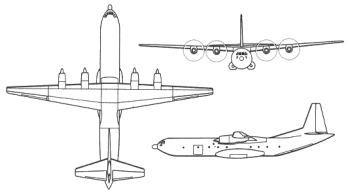



For a time, the Douglas C-133 Cargomaster was the largest heavy transport of the USAF, capable of carrying almost twice the load of the C-124. The C-133 featured high-mounted wings, enlarged side and tail doors as well as a large open and pressurized cargo area which could transport ballistic missiles such as the Atlas, Thor, and Jupiter as well as other heavy cargo including fully assembled tanks. Over the course of their service life, C-133s set numerous unofficial records for aircraft of their type on both trans-Atlantic and Pacific routes although their extensive use well beyond their expected airframe life led to serious stress corrosion issues although it was still necessary to maintain the fleet until a replacement was available; this would be the C-5 Galaxy which supplanted the last Cargomaster in 1971. Other uses for the C-133 were as a transport for launch boosters to Cape Canaveral for use in NASA's space programs.
The first production C-133 had its maiden flight on 23 April 1956 (no prototype was built) and began entering service the following year as the C-133A. These were followed in production by the definitive C-133B which introduced more powerful engines, increased loaded weight, and an enlarged cargo door.
Preceded by:
NoneSucceeded by:
None | |
| Design | C-133B |
| Name | Cargomaster |
| Type | Transport |
| Year | 1957 |
| Crew | 6 |
| Dimensions | |
| Length | 48.01 m |
| Height | 14.707 m |
| Wing Span | 54.76 m |
| Wing Area | n/a |
| Weight | |
| Empty | 49,631 kg |
| Maximum | 100,000 kg |
| Wing Loading | 402.7 kg/m² |
| Performance | |
| Speed | 578 km/h |
| Ceiling | 9,129 m |
| Range | 7,000 km |
| Powerplant | |
| Engine | 4 x T34-P-9W Pratt & Whitney 5,593 kW |
| Thrust/Weight | 0.55 |
| Armament | |
| Guns | - |
| Payload | 49,896 kg |
| Production | |
| Built | 15 |
| Total | 50 |